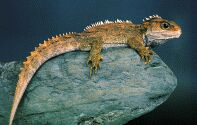Study: Fastest-known evolving animal is the tuatara
(Agencies)
Updated: 2008-03-28 13:57
Updated: 2008-03-28 13:57
The fastest-known evolving animal is the Sphendon punctatus, or tuatara, a so-called "living dinosaur" that looks a lot like a lizard is found only in New Zealand, according to scientists.
The tuatara is the only surviving member of a reptilian order Sphehodontia that lived alongside early dinosaurs and separated from other reptiles 200 million years ago in the Upper Triassic period.

Researchers recovered DNA sequences from the bones of ancient tuatara to estimate its evolutionary velocity. The team discovered although tuatara have remained largely unchanged physically over very long periods of evolution, they are evolving -- at a DNA level -- faster than any other animal yet examined.The results will be detailed in the March issue of the journal Trends in Genetics.
"What we found is that the tuatara has the highest molecular evolutionary rate that anyone has measured," said researcher David Lambert from the Allan Wilson Centre for Molecular Ecology and Evolution in New Zealand.
Many scientists have theorized molecular evolution would take place at a faster rate in animals whose physical form, or morphology, also evolved swiftly. The tuatara finding suggests otherwise, that there is no relationship between the two rates.
"Of course we would have expected that the tuatara, which does everything slowly -- they grow slowly, reproduce slowly and have a very slow metabolism -- would have evolved slowly," Lambert said. "In fact, at the DNA level, they evolve extremely quickly."
The rate of evolution for Adélie penguins, which Lambert and his team have studied in the Antarctic for many years, is slightly slower than that of the tuatara. The tuatara rate is significantly faster than for other animals that have been studied, including the lion, ox, horse and the now-extinct cave bear.
"We want to go on and measure the rate of molecular evolution for humans, as well as doing more work with moa and Antarctic fish to see if rates of DNA change are uncoupled in these species," Lambert said. "There are human mummies in the Andes and some very good samples in Siberia where we have some collaborators, so we are hopeful we will be able to measure the rate of human evolution in these animals too."
|
||
|
||
|
|
|
|